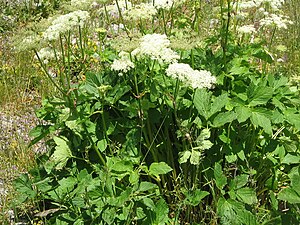Note: This is a project under development. The articles on this wiki are just being initiated and broadly incomplete. You can Help creating new pages.
Difference between revisions of "Peucedanum ostruthium - Vietnamese mint"
(Created page with "thumb|right|''Peucedanum ostruthium'' '''Peucedanum ostruthium''' or '''Imperatoria ostruthium''', '''Masterwort''', is a species of flo...") |
Chaithrika (talk | contribs) (+Common names) |
||
| Line 12: | Line 12: | ||
<ref name="uses">[https://www.ncbi.nlm.nih.gov/pmc/articles/PMC3791396/ "Ethnopharmacological in vitro studies on Austria's folk medicine - an unexplored lore in vitro anti-inflammatory activities of 71 Austrian traditional herbal drugs"]</ref> | <ref name="uses">[https://www.ncbi.nlm.nih.gov/pmc/articles/PMC3791396/ "Ethnopharmacological in vitro studies on Austria's folk medicine - an unexplored lore in vitro anti-inflammatory activities of 71 Austrian traditional herbal drugs"]</ref> | ||
</references> | </references> | ||
| + | |||
| + | ==Common name== | ||
| + | |||
| + | * '''Hindi''' - छकरिपूल | ||
== External Links == | == External Links == | ||
Revision as of 12:01, 8 March 2017
Peucedanum ostruthium or Imperatoria ostruthium, Masterwort, is a species of flowering plant in the family Apiaceae. It is native to the mountains of Central and Southern Europe, but has been widely introduced outside its native range.
Contents
Uses
Masterwort is used as a flavouring for various liqueurs and bitters. Its roots and leaves have been used in the traditional Austrian medicine internally (as tea, liqueurs and wine) and externally (as fumigation, tincture or incense) for treatment of disorders of the gastrointestinal tract, skin, respiratory tract, cardiovascular system, infections, fever, flu and colds.[1]
References
Common name
- Hindi - छकरिपूल
